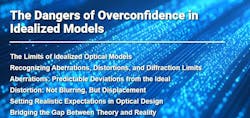The Dangers of Overconfidence in Idealized Models
The Limits of Idealized Optical Models
Idealized optical models provide a simplified framework for understanding how a system might behave under perfect conditions. However, overconfidence in these models can be misleading, particularly for those with less experience in the field. Theoretical models are built on assumptions that don’t hold true in practice—real light has width, real lenses have imperfections, and perfect point sources simply don’t exist.
While estimations and simplifications are necessary for calculations, it’s crucial to understand the boundaries of these models and recognize the confidence intervals within which your predictions are valid. Overlooking these limitations can result in a gap between expected and actual performance.
Recognizing Aberrations, Distortions, and Diffraction Limits
To prevent disappointing outcomes, it’s important to recognize that aberrations and distortions are intrinsic to all optical systems. This article, part of a six-part series on avoiding optical pitfalls, explains foundational concepts that can help set realistic expectations.
